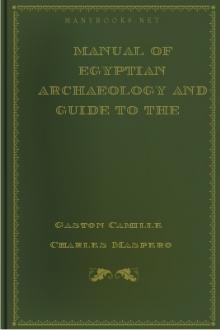Ancient America, in Notes on American Archaeology by John D. Baldwin (best thriller books to read .TXT) 📕

"It is in the form of a serpent, upward of 1000 feet in length, extended i
Read free book «Ancient America, in Notes on American Archaeology by John D. Baldwin (best thriller books to read .TXT) 📕» - read online or download for free at americanlibrarybooks.com
- Author: John D. Baldwin
- Performer: -
Read book online «Ancient America, in Notes on American Archaeology by John D. Baldwin (best thriller books to read .TXT) 📕». Author - John D. Baldwin
The ruins in Northern Mexico, including New Mexico and Arizona, consist chiefly, as already stated, of the remains of structures similar in general design and purpose to those of the Village Indians, the Pueblos. In the more ancient times, doubtless, as at present, a large proportion of the dwellings and other edifices, like those in the Mississippi Valley, were built of perishable materials which have left no trace. Many of them, however, were built of stone, and have left ruins which show their character. Stone ruins are common in this northern region, although wood and adobe seems to have been more commonly used as building material. Some of the ruined stone edifices were inhabited when the country was conquered by the Spaniards. The remains present every where the same characteristics. They represent a people who built always in the same way, with some variations in the forms of their structures, and had substantially the same condition of life; but the ruins are not all of the same age. Their character can be sufficiently shown by describing a few of them.
In New Mexico, west of the Rio Grande, between the head waters of the San Jose and Zuni rivers, a bluff or ridge rises in a valley two hundred feet high. The Spaniards named it “El Moro.” One side of this bluff is vertical, and shows yellowish-white sandstone rock, on the face of which are inscriptions; “Spanish inscriptions and Indian hieroglyphics.” It was carefully described in 1849 by Lieutenant Simpson, and was explored again four or five years later by Lieutenant A. W. Whipple, who described it in his report to the government, published in the third volume of “Explorations and Surveys for a Railroad Route to the Pacific.” On the summit of this height, which Lieutenant Simpson named “Inscription Rock,” are the ruins of an extensive Pueblo edifice built of stone. The walls were built “with considerable skill.” In some places they are still “perfect to the height of six or eight feet, vertical, straight, and smooth; and the masonry is well executed, the stones being of uniform size—about fourteen inches long and six wide.” The layers are horizontal, each successive layer breaking joints with that below it. Remains of cedar beams were discovered, and also obsidian arrow-heads, painted pottery, and other relics. Another ruin was seen on a height across the gorge. It was found to be similar to this, both in character and condition of decay.
Lieutenant Whipple went westward along the thirty-fifth parallel. We can not do better than follow the report of what he saw.
His next stopping-place, after leaving “El Moro,” was in the beautiful valley of Ojo Pescado. Here, close by a spring that showed artificial stone-work of ancient date, were two old Pueblo buildings in ruins, “so ancient that the traditions of present races do not reach them.” Not far away is a deserted town of later date. The two ancient structures were circular in form and equal in size, each being about eight hundred feet in circumference. They were built of stone, but the walls have crumbled and become chiefly heaps of rubbish. The pottery found here, like that at “El Moro,” is “painted with bright colors, in checks, bands, and wavy stripes; many fragments show a beautiful polish. A few pieces were discovered larger in size, inferior in color and quality, but indicating a more fanciful taste. United, they formed an urn with a curious handle; a frog painted on the outside and a butterfly within.” In the same neighborhood, on the summit of a cliff twenty feet high, was another old ruin “strongly walled around.” In the centre was a mound on which were traces of a circular edifice.
The next place of encampment was at Zuni, where, as shown in Figure 21, can be seen one of these great Pueblo buildings inhabited by two thousand people (Lieutenant Whipple’s estimate). It has five stories, the walls of each receding from those below it. Looking from the top, he says it reminded him of a busy ant-hill, turkeys and tamed eagles constituting a portion of its inhabitants. Not more than a league away is an “old Zuni” which shows nothing but ruins. Its crumbling walls, worn away until they are only from two to twelve feet high, are “crowded together in confused heaps over several acres of ground.” This old town became a ruin in ancient times. After remaining long in a ruined condition it was again rebuilt, and again deserted after a considerable period of occupation. It is still easy to distinguish the differences in construction between the two periods. “The standing walls rest upon ruins of greater antiquity;” and while the primitive masonry is about six feet thick, that of the later period is only from a foot to a foot and a half thick. Small blocks of sandstone were used for the latter. Heaps of débris cover a considerable space, in which, among other things, are relics of pottery and of ornaments made of sea-shells. Pieces of quaintly-carved cedar posts were found here, and their condition of decay, compared with that of the cedar beams at “El Moro,” “indicated great antiquity.” The place of this ruin is now one of the consecrated places of the Village Indians; it has “a Zuni altar” which is constantly used and greatly venerated. On leaving the place, their guide blew a white powder toward the altar three times, and muttered a prayer. This, he explained, was “asking a blessing of Montezuma and the sun.” This altar seems to represent recollections of the ancient sun-worship.
At a place west of Zuni ancient relics were found, indicating that an extensive Pueblo town had formerly stood there, but “the structures were probably of adobes,” as there was no débris of stone walls, and only very faint traces of foundations. Near the Colorado Chiquito is an extensive ruin, on the summit of an isolated hill of sandstone, the faces of its walls being here and there visible above heaps of débris. It appears to be very old. As near as could be ascertained, the great rectangular Pueblo building was three hundred and sixty feet in extent on one side, and one hundred and twenty on the other. In some places the walls are ten feet thick, “with small rooms inserted in them.” Stone axes, painted pottery, and other articles are found in the débris: “The indented pottery, said to be so very ancient, is found here in many patterns.” On a ridge overlooking the valley of Pueblo Creek are traces of an old settlement of large extent, supposed to have been that heard of in 1539 by the friar Marco de Niça as “the kingdom of Totonteac.” Adobe seems to have been used here for building. Traces of other ruins were seen in various places, and springs along the route showing ancient stone-work are mentioned.
Ruins are abundant in the Rio Verde Valley down to the confluence of that river with the Rio Salinas. It is manifest that this whole region was anciently far more populous than it is now. Lieutenant Whipple says, “Large fields in the valley of the Rio Gila, and many spots among the Pinal Lena Mountains, are marked with the foundations of adobe houses.” Figure 22 represents a Pueblo ruin in the Valley of the Gila. “In Cañon Chelly, near San Francisco Mountain, and upon Rio Verde, there are ruins of more permanent structures of stone, which in their day must have excelled the famed Pueblos of New Mexico.” There was a higher degree of civilization in the ancient times, so far as relates to architecture and skill in the arts and appliances of life, than has been shown by people of the same race dwelling there in our time; but the ancient condition of life seems to have been maintained from age to age without material change.
THE “SEVEN CITIES OF CEVOLA.”In the New Mexican valley of the Chaco, one degree or more north of Zuni, are ruins of what some suppose to have been the famous “Seven Cities of Cevola.” In 1540, Spanish cupidity having been strongly incited by tales of the greatness and vast wealth of Cevola, Coronado, then governor of New Galicia, set out with an army to conquer and rob its cities. The report in which he tells the story of this conquest and of his disappointment is still in existence. The Cevolans defended themselves with arrows and spears, and hurled stones upon his army from the tops of their buildings. But resistance was of no avail; Cevola was conquered by Coronado, and immediately deserted by all its inhabitants who escaped death. The conquering buccaneer, however, did not find the treasures of gold and silver he expected. Three hundred and thirty years or more have passed away since this expedition of the Spanish marauders was undertaken, but the “Seven Cities of Cevola” (if they really were the “cities” whose remains are found in the Chaco Valley), although much dilapidated, are still sufficiently well preserved to show us what they were.
There are seven ruins in the Chaco Valley, all of the same age, from one to three miles apart, the whole line along which they are situated being not more than ten miles in extent. Coronado said of Cevola, “The seven cities are seven small towns, standing all within four leagues together;” and “all together they are called Cevola.” The Chaco ruins show that each of these “cities” was, Pueblo fashion, a single edifice of vast size, capable of accommodating from five hundred to three thousand people. They were all built of stone, around three sides of a square, the side opposite the main building being left open. Figure 23 represents one of these buildings restored, according to Lieutenant Simpson. Figure 24 is a ground plan of this structure. The outer faces of the walls were constructed with thin and regular blocks of sandstone; the inner surfaces were made of cobblestone laid in mortar, and the outer walls were three feet thick. They were four or five stories high, and the only entrances to them were “window openings” in the second story. Above the cañon inclosing the valley containing these ruins, at a distance of thirteen miles, are the remains of another “city” of precisely the same kind. Its walls are at present between twenty and thirty feet high, their foundations being deeply sunk into the earth. Lieutenant Simpson, who explored that region in 1849, says it was built of tabular pieces of hard, fine-grained, compact gray sandstone, none of the layers being more than three inches thick. He adds, “It discovers in the masonry a combination of science and art which can only be referred to a higher stage of civilization and refinement than is discoverable in the work of Mexicans or Pueblos of the present day. Indeed, so beautifully diminutive and true are the details of the structure as to cause it at a little distance to have all the appearance of a magnificent piece of mosaic.”





Comments (0)